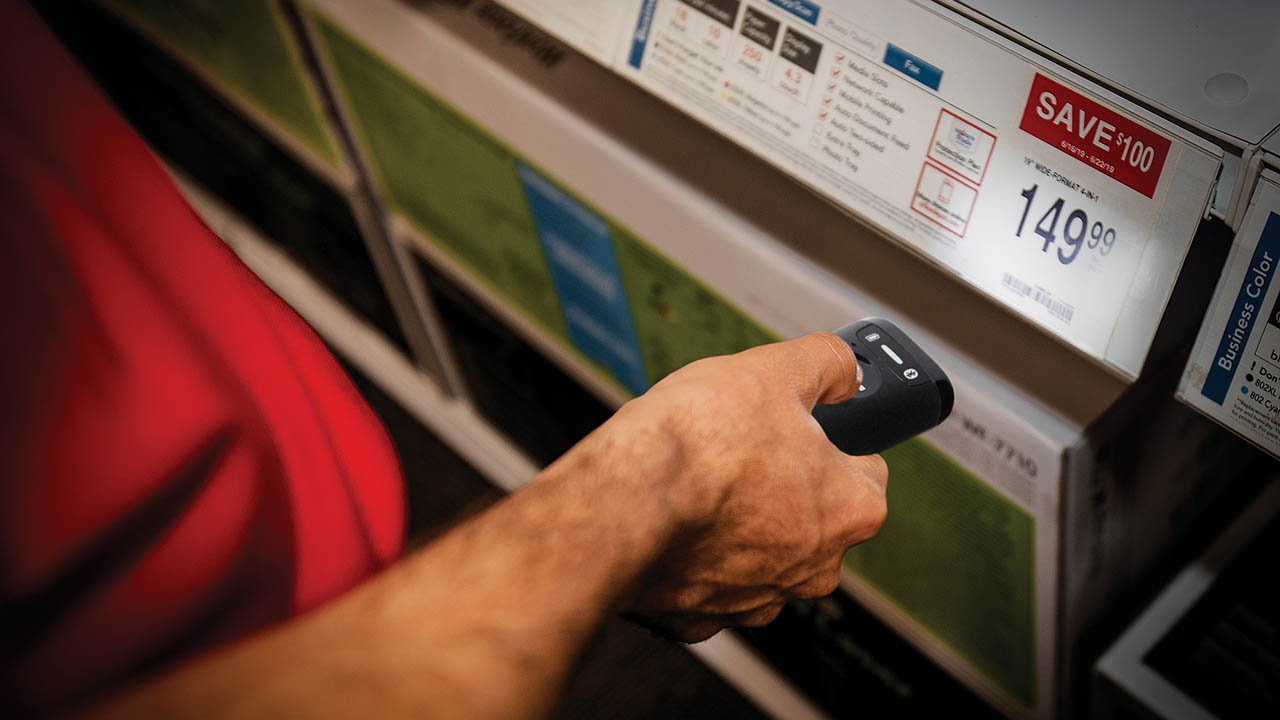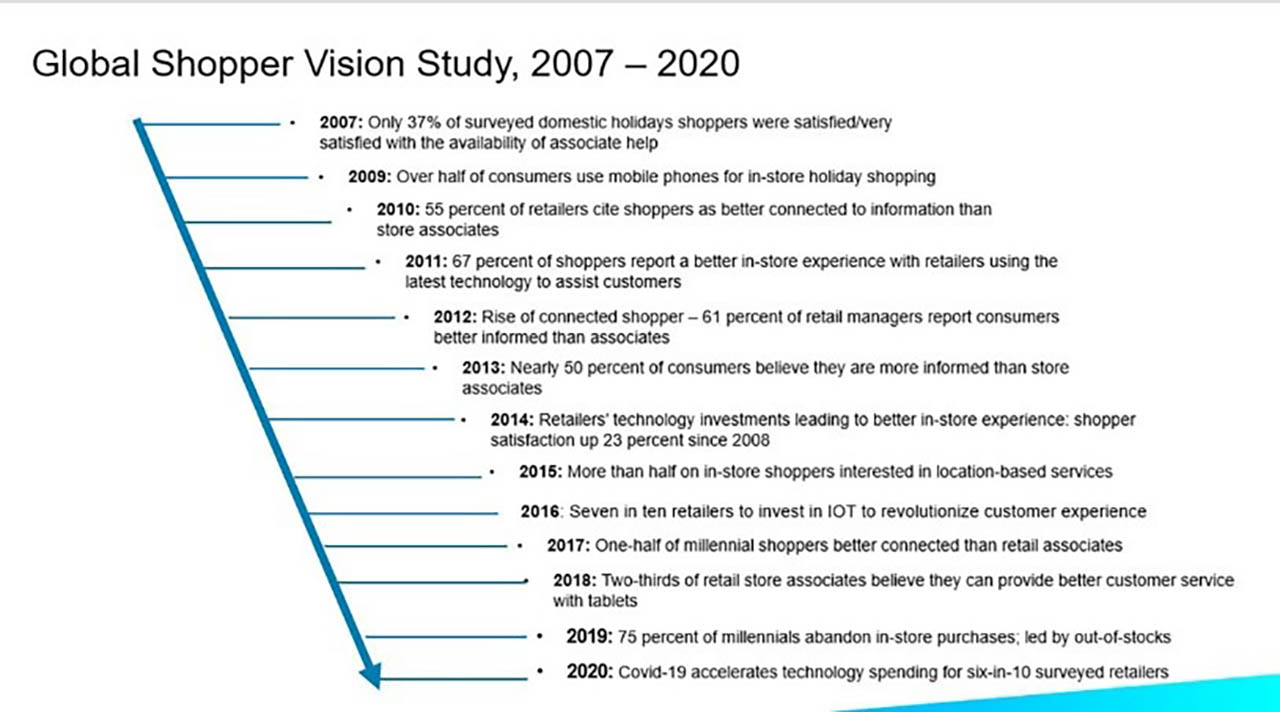
Consumers Aren’t the Only Ones Shopping for the Hottest Tech This Holiday Season
Retailers are just as excited about the latest handheld mobile computers, tablets and wearables as their customers are this year. They’re also intrigued by robots, artificial intelligence (AI) and augmented reality (AR) among many other “hot technologies.” That’s because they aren’t just retailers looking to move product. They’re technologists who want to be smarter, speedier and more in sync with those who are helping to keep their doors open and shelves stocked. They want to know what both customers and employees want at all times – and they want the means to deliver those things as effortlessly as possible, with as little contact as possible.
That was clear in the feedback received during the compilation of Zebra’s 13th Annual Global Shopper Study.
But retailers’ burgeoning interest – and investment – in technology isn’t just about the digitalisation of operations or the personalisation of shopping experiences. Nor is it a knee-jerk reaction to the supply chain constraints or safety concerns triggered by the pandemic. Though six-in-10 retailers worldwide admit that COVID-19 has been a catalyst for accelerated spending plans, retailers have long understood the value of technology.
Retail modernisation has been top of mind for years now, and it’s not just something that the sector has been talking about at tradeshows or behind closed doors.

We were helping our customers implement Internet of Things (IoT) solutions in storefronts and stockrooms with great success long before the term “new normal” was uttered. Retailers were embracing mobility solutions, kiosks, barcode scanners and other technologies that could facilitate contactless interactions well over a decade ago. And we shared several examples on the Your Edge blog last year of retailers who had begun implementing radio frequency identification (RFID), AR, Bluetooth® beacons and other more advanced technologies in backrooms and storefronts to help usher retail into a new era. In fact, we had just wrapped up the first wave of the Modern Retail Collective in Mall of America and were planning for the second wave when COVID-19 halted the program. In other words, COVID-19 didn’t suddenly turn retailers onto the many benefits of technology within their four walls.
Granted, safety wasn’t the main motivator for modernisation back then as it is in many cases today. Speed and convenience were the primary drivers. But, if you think about it, speed is a key component to safety in terms of shopper and associate interactions, and convenience is the key to securing customer loyalty, whether the transaction occurs in store or online. Therefore, the reasons for prioritising contactless solution deployments hasn’t changed all that much. The only difference now is that retailers have to offer these types of shopping experiences if they want to earn consumers’ business.
That was something that both shoppers and associates made clear in this year’s Global Shopper Study.
A Matter of Trust: More Needs to Be Done to Show Shoppers and Associates (via Technology) That Their Needs and Wants are Being Heard
Though most retail decision makers (91%) think shoppers and associates trust them to make health and safety a priority, only 65% of shoppers and 77% of associates actually do. Nearly two-thirds (67%) of shoppers are either concerned that surfaces aren’t being properly sanitised or that they’re still too exposed to people when they go into stores, and almost just as many (60%) say that the lines to either enter the store or checkout are too long – which increases exposure to others.
In fact, the number one thing shoppers want from retailers today (76%) is to be able to get in and out of the store quickly, and they have a few ideas on how retailers can make that happen. Among them are preferences for self-checkout lanes (63%) and contactless payment options in store (59%). The majority of shoppers also believe that more retailers need to offer a mobile ordering option (64%) that would allow for either curbside or in-store pickup or direct delivery to their homes.
Fortunately, the vast majority of decision makers and store associates agree these low-touch/no-touch checkout options would help meet customer expectations and free up staff to focus on other tasks that improve the entire customer experience, such as shelf replenishment, and ensure compliance with health and safety protocols. I would imagine that, in the coming months, most shoppers are going to notice positive changes in how retailers deliver goods and services.
We’ve already been working with several retailers around the world to implement such solutions using a combination of handheld mobile computers, tablets, scanners and other devices. For example:
- Dutch retailer Jumbo recently deployed a new self-scanning solution to introduce exciting innovations such as in-store navigation and assistance to shoppers.
- New Zealand retail chain PAK'nSAVE Stores has given its customers access to a personal shopper system that enables them to scan as they go, reducing the time they spend in store up to 30 minutes.
- Jem and Fix, a major DIY retailer in the Nordics, is leveraging mobile computing technology to support store associates with always-ready information, including inventory levels, delivery status and near-by store stock to ensure they can help get products to customers when they need them.
- Walgreens upgraded to a data-rich mobility solution to ensure product locationing and inventory management weren’t so laborious. This in turn empowered associates to better serve its more than 8 million customers.
We’re also helping retailers develop and rollout smart kiosks that act as self-service concierges, helping customers locate desired items so that they don’t walk out of the store empty handed.
But these aren’t the only technologies on retailers’ wish lists this year, and it’s quite possible that consumers may never actually see the other ways that retailers are innovating to improve both brick-and-mortar and e-commerce operations.
What You Don’t See Happening Right Now (Even Though It Is)
There is much being done behind the scenes to help retailers better see what consumers are actually experiencing in store and online – and why. In fact, two of retailers’ top three technology priorities over the next five years are workforce software (#1) and prescriptive analytics (#3). Distributed order management rounded out the top five.
Retailers are also astutely aware that, in order to make customers happy, associates have to be able to see and act on inventory issues as they’re happening to ensure customers’ needs are met whether shopping in store or online. Just like shoppers, staff also has to feel safe in the work environment if they are to be as attentive and productive as possible. This is true whether they’re in the stockroom, out on the floor or on the receiving dock.
One way to do this is to implement technologies that help associates better manage the growing volume of online orders being fulfilled at the store level. Whether picking from dark stores or the same shelves as your in-store shoppers, they have to be able to do so in an efficient and socially distanced way. That can be hard if you overschedule staff or ask them to fulfill an unreasonable number of orders in a very short period of time. It’s one of the fastest ways to deplete their energy and morale.
You also don’t want online orders depleting inventory faster than it’s coming in from the warehouse. Of course, that can’t always be prevented. So, you at least need to be aware when it is occurring so that you can trigger a reorder and minimise the time that items are out of stock. This will also help ease associates from shouldering shopper complaints about cancelled items.
At the same time, retail is very much a seasonal business, with workforce levels fluctuating more frequently than other sectors. Retailers can’t afford for workers to have a long ramp-up period. They need to be able to clock in on day one and, with minimal training or oversight, be able to complete tasks that positively impact the shopper experience, whether specific to backroom management, shelf inventory, pricing, point of sale or sanitation activities. Giving associates mobile computers that constantly prescribe specific actions – with the who, what, where, when and why detailed – will enable them to better serve customers. And the more positive feedback that they receive via customer surveys or a friendly smile, the more motivated they will be to keep up the good work and even go the extra mile.
(My colleagues will be divulging more about the correlation between associate satisfaction and customer satisfaction and the role that various technologies play in achieving both in upcoming blog posts. I encourage you to subscribe to Your Edge now, if you haven’t already, so that you can be among the first to know when those insights become available.)
A Unified Front (of Store)
For me, the most glaring takeaway from our latest Shopper Study is that retailers, associates and consumers are all aligned on what defines a great shopping experience right now, even if they aren’t equally satisfied with how things unfolded in 2020:
- Retailers spent much of the year in the weeds, just trying to respond to the dynamic variables of a global pandemic and – when possible – regain an operational edge. Although it wasn’t always smooth sailing due to the constant imbalance of supply and demand, labor shortages and more, retailers know things could have been much worse, for much longer. Overall, they believe shoppers and associates to be happier than they actually are.
- Shoppers don’t agree that things went as well as they could have. Perhaps that’s because they rely so heavily on retailers for sustenance and felt let down when retailers couldn’t deliver. Many people I know were just as disappointed that they lost access to the little luxuries in life as they were that they couldn’t track down toilet paper. They were bummed that they couldn’t get a new read from their favorite local book store or browse seasonal offerings without worrying about the risks – assuming their preferred retailers even had the means to comply with social distancing mandates and reopen safely. Of course, the months-long hunt for essentials grew tiresome, and that certainly skewed customer satisfaction levels downward.
- Associates are somewhere in the middle. They have more confidence in retailers than shoppers, but believe there’s still room for improvement when it comes to safety, inventory management and other factors that impact the in-store and online retail experience these days.
In other words, it seems like the loss of trust in retailers’ ability to meet basic expectations – whether in regards to safety or shelf stock – is what really caused satisfaction to wane in 2020. (It dropped six percentage points from 2019.)
As shoppers’ habits continue to shift and they increasingly view (and rate) the online and in-store experience as one in the same, retailers must start shopping themselves for technologies that can enable a “unified commerce” model. This is retail’s new normal. Or should I say, this is retail’s normal now. We’re no longer talking about omnichannel or the convergence of physical and digital in terms of “what’s to come.” Perhaps ironically, the “future” of retail arrived early.
As you start your market research and meet with technology solution providers to compare specs, test features and confirm capabilities, be sure to think about how each hardware or software component will help you either:
- deliver a low touch/no touch experience;
- improve product availability and selection;
- maintain competitive (and accurate) pricing;
- minimise losses due to fraud or shrink;
- better detect when customers are unhappy and why;
- empower your associates to see more, do more and be more satisfied with the important role they’re playing in society today; and/or
- remain agile, operationally speaking.
You never know what the future may drop on your doorstep. But, if you get the right technologies in the hands of associates and shoppers, they too will be better able to adapt as supply and demand fluctuates and expectations evolve.
###
Related Reads:
- Are Contactless Technologies the Key to Staying Connected with Retail and Hospitality Customers During COVID-19?
- Want to Provide a More Interactive Customer Experience? Turn Your Attention to Kiosk Technologies
- Kiosks are Becoming a Booming Business. This is How Your Business Can Take Advantage.
- These are the Emerging Technologies That Can Help Workers, Customers Practice Social Distancing More Successfully
- Are Your Workers Getting Too Close to One Another? This New Mobility Solution Will Alert Them to Step Back (and Help You Take Action When Needed)
- 6 Ways That Prescriptive Analytics Can Help Retailers and Grocers Ensure Policy Compliance by Employees and Customers Alike

Mark Thomson
What’s happening in retail? How has the shift in shopping behavior impacted retailers around the world and will robots take over? Mark Thomson’s exploration of the global retail landscape helps retailers gain a focus on what’s real and what works when building a retail strategy in a digital world.
As Director of Retail Industry Solutions at Zebra Technologies, Mr. Thomson works closely with retailers and hospitality businesses to provide input on how to face the challenge of a new digital retail landscape, where customers are often more connected and informed than shop floor staff. Mr. Thomson helps retailers focus on developing a vision for their retail business that aims to improve customer experience and drive business efficiencies.
With over 27 years of customer-focused experience, Mr. Thomson has developed in-depth knowledge of the EMEA and global retail marketplace and regularly speaks at industry events throughout the EMEA region including World Retail Congress, Retail Middle East, RBTE and Euroshop. He has worked closely with retailers on the pain points of modern retail and explains how technology solutions can be an integral part of their business strategy to help them solve their real business challenges from supply chain to store.
Prior to joining Zebra, Mr. Thomson held senior roles in Financial Services and Hospitality businesses.






